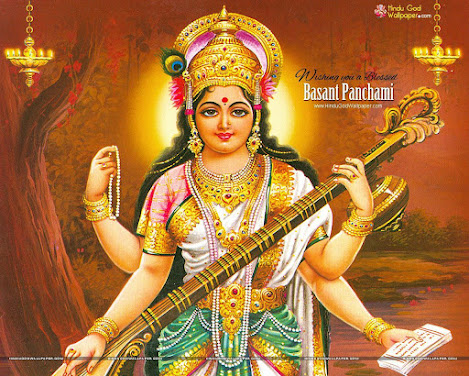Vasant Panchami - '24
Vasant Panchami, also rendered Vasanta Panchami and
Saraswati Puja in honour of the Hindu goddess Saraswati, is a jubilee that
marks the medication for the appearance of spring. The jubilee is celebrated in
Indian persuasions in different ways depending on the region. Vasant Panchami
also marks the launch of medication for Holika and Holi, which take place forty
days latterly. The Vasant Utsava (jubilee) on Panchami is famed forty days
before spring, because any season's transition period is 40 days, and after
that, the season comes into full bloom. Vasant Panchami is famed every time on
the fifth day of the bright half of the Hindu lunisolar timetable month of
Magha, which generally falls in late January or February. Spring is known as
the" King of all Seasons", so the jubilee commences forty days in
advance. It's generally downtime- suchlike in northern India, and further
spring- suchlike in central and western corridor of India on Vasant Panchami,
which gives credence to the idea that spring is actually in full bloom 40 days
after the Vasant Panchami day. The jubilee is particularly observed by Hindus
in the Indian key, specially India and Nepal. It has been a literal tradition
of Sikhs as well. In southern countries,
the same day is called Sri Panchami. On the island of Bali and the Hindus of
Indonesia, it's known as "Hari Raya Saraswati" (great day of
Saraswati). It also marks the morning of the 210- day long Balinese Pawukon
timetable. Vasant Panchami is a jubilee of Hindus and Sikhs that marks the
morning of medications for the spring season. It's celebrated by people in colorful
ways depending on the region. Vasant Panchami also marks the launch of
medication for Holika and Holi, which do
forty days latterly. For numerous,
Vasant Panchami is the jubilee devoted to goddess Saraswati who's their goddess
of knowledge, language, music, and all trades. She symbolizes creative energy
and power in all its forms, including
craving and love. The season and
jubilee also celebrate the agrarian fields' growing with
unheroic flowers of mustard crop, which Hindus associate with
Saraswati's favorite color. People dress in unheroic saris or shirts or
accessories, share unheroic-
multicolored snacks and sweets. Some add saffron to their rice and also eat
unheroic cooked rice as a part of an elaborate feast. numerous families mark
this day by sitting with babies and youthful children, encouraging their
children to write their first words with their fritters, and some study or produce music together. The day before Vasant
Panchami, Saraswati's tabernacles are filled with food so that she can join the
celebrators in the traditional feasting the following morning. In tabernacles
and educational institutions, statues of Saraswati are dressed in unheroic and
worshiped. numerous educational institutions arrange special prayers or pujas
in the morning to seek the blessing of the goddess. lyrical and musical
gatherings are held in some communities in reverence for Saraswati. In Eastern India, primarily in the countries
of West Bengal, Bihar, Tripura and Assam, as well as in Nepal, people visit
Saraswati tabernacles and also worship Goddess Saraswati at home( Saraswati
Puja). In West Bengal, it's one of the major carnivals for Bengali Hindus and
observed by numerous homes; utmost seminaries arrange Saraswati puja for their
scholars on their demesne. In Bangladesh too, all major educational institutes
and universities observe it with a vacation and a special puja. In the state of
Odisha, the jubilee is celebrated as Basanta Panchami/ Sri Panchami/ Saraswati
Puja. Homas and Yagnas are done in seminaries and sodalities across the state.
scholars celebrate Saraswati puja with great sincerity and vehemence.
generally, children four and five times old start learning on this day in a
unique form named 'Khadi- Chuan' or' Vidya- Arambha',- this is known as"
Haate- Khori" among Bengali Hindus. In southern countries similar as
Andhra Pradesh, the same day is called Sri Panchami where" Sri"
refers to her as another aspect of the one goddess Devi. Another legend behind
Vasant Panchami is grounded on the Hindu god of love called Kama. Pradyumna is
Kamadev externalized in Krishna's Book. therefore Vasant Panchami is also known
as" Madana Panchami". Pradyumna is the son of Rukmini and Krishna. He
awakens the heartstrings of the earth (and its people) and therefore the world
blooms again. It's flashed back as the day when the foreseers (Rishis)
approached Kama to wake up Shiva from his Yogic contemplation. They support
Parvati who's doing a penance to get Shiva as hubby and seek Kama's help to
bring Shiva back from his contemplation to worldly solicitations. Kama agrees
and shoots arrows, made of flowers and notions, at Shiva from his heavenly arc
of sugarcane in order to arouse him to pay attention to Parvati. Lord Shiva
awakens from his contemplation. When his third eye opens, a dynamo is directed
to Kama. Kama the Lord of solicitations is burnt to ashes. This action is
celebrated by Hindus as Vasant Panchami. Vasant Panchami is associated with
the feelings of love and emotional expectation in Kutch( Gujarat) and is
celebrated by preparing bouquets and libraries of flowers set with mango
leaves, as a gift. People dress in saffron, pink, or unheroic and visit each
other. Songs about Krishna's capriccios
with Radha, considered to glass Kama- Rati, are sung. This is represented with
the Hindu deity Kama with his woman
Rati. Traditionally, in Maharashtra, Madhya Pradesh, Chhattisgarh and Uttar
Pradesh, after bathing in the morning, people worship Shiva and Parvati.
Immolations of mango flowers and the cognizance of wheat are traditionally
made. People celebrate the day by wearing unheroic (white), eating sweet dishes
and displaying unheroic flowers in
homes. In Rajasthan, it's customary for people to wear jasmine libraries. In
Maharashtra, recently married couples visit a tabernacle and offer prayers on the first Basant Panchami after the marriage. wearing unheroic dresses. In the
Punjab region, Sikhs and Hindus wear unheroic turban or headgear. In
Uttarakhand, in addition to Saraswati Puja, people worship Shiva, Parvati as
the mama earth and the crops or husbandry.
People eat unheroic rice and wear unheroic. It's also a significant academy inventories shopping and affiliated gift- giving season. In the Punjab
region, Basant is celebrated as a seasonal
jubilee by all faiths and is known as the Basant Festival of harpies.
Children buy dor (thread) and guddi or patang (harpies) for the sport. The people of the Punjab wear unheroic clothes and eat unheroic rice to emulate the unheroic mustard (sarson) flower fields, or
play by flying harpies. According to
Desai (2010), the tradition of flying harpies on colorful carnivals is also set up in northern and western Indian countries Hindus in Rajasthan and especially
in Gujarat associate vampire flying with
the period previous to Uttarayan; in
Mathura( Uttar Pradesh), harpies are
flown on Dussehra; in Bengal vampire
flying takes place on Viskwakarma Puja in September. The sport is also set up in Maharashtra, Madhya Pradesh
and corridor of south India. On Bali and among Indonesian Hindus, Hari
Raya Saraswati (the jubilee's original
name) is celebrated with prayers in family
composites, educational institutions, and public venues from morning to
noon. preceptors and scholars wear brightly coloured clothes rather of their
usual uniforms, and children bring traditional
galettes and fruit to academy for
immolations in a tabernacle. Namdhari Sikhs
have historically celebrated Basant Panchami to mark the morning of spring.
Other Sikhs treat it as a spring jubilee, and joyfully celebrate it by
wearing unheroic multicolored clothes, emulating the
bright unheroic mustard flowers in the
fields.



Comments
Post a Comment